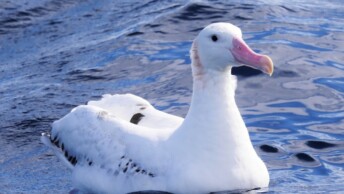Loons, or divers, are large aquatic birds of the genus Gavia (family Gaviidae), renowned for their haunting calls, striking plumage, and mastery of underwater pursuit. All five of the world’s species occur in North America, from the widespread common loon to the smaller red-throated and Pacific loons, and the far northern Arctic and yellow-billed loons. Built for life on the water, they have dense bones, strong rear-set legs, and long, tapered bodies that make them exceptional divers but awkward on land.
This guide covers the loons found across the United States and Canada, highlighting how to recognize each species by its appearance, voice, and habits, and where they can be found across their breeding and wintering ranges.
Common Loon
Gavia immer
- Identification: Large, heavy-bodied loon with a black head, white-checkered back, and dagger-like bill in summer; gray above and white below in winter.
- Where found: Breeds across Canada, Alaska, and the northern United States; winters mainly along both coasts and large inland lakes and reservoirs.
- How to spot: Look for its striking black-and-white summer plumage and listen for haunting wails and tremolos across northern lakes; in flight shows long, straight neck and feet trailing behind the tail.
- Conservation status: Least Concern (IUCN); populations stable overall but declining locally at southern range edges due to pollution, lead poisoning, and habitat disturbance.

The common loon is one of the most iconic birds of northern North America, its haunting calls echoing across clear, secluded lakes. It’s a large loon species, measuring 66 to 91 centimeters (26 to 35.8 inches) in length, with a long, heavy body, straight bill, and strong, low-set legs built for swimming rather than walking. On land it moves awkwardly, but on water it is agile and powerful, diving with precision in pursuit of fish.
Adults in breeding plumage display a bold black head and neck marked by white vertical stripes and a checkered black-and-white back, while the breast and belly are pure white. In non-breeding plumage they turn plain gray above and white below, with a paler bill. Males and females look alike, though males are slightly larger and heavier. Juveniles are gray-brown with pale-edged feathers on the back, giving a scalloped look, and gradually acquire adult patterning over two years.
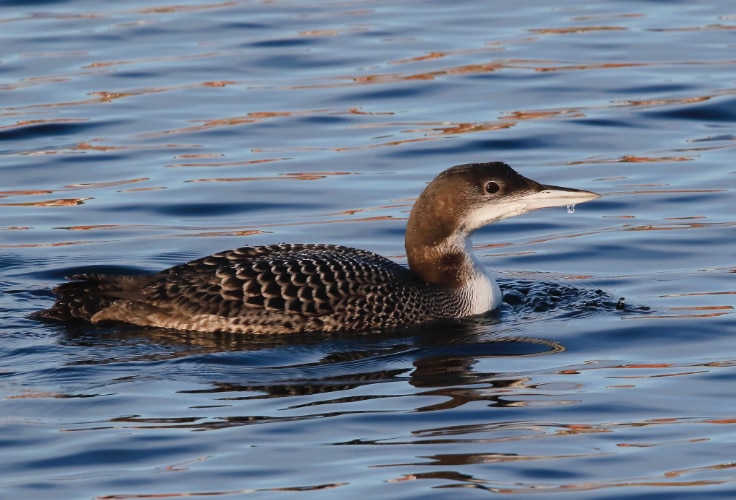
On the water, loons sit low with the body submerged and the head held erect. They dive cleanly, often vanishing in a smooth motion, and resurface several seconds or even minutes later with a fish clasped in the bill. In flight, they appear long and level-bodied, with the feet extending beyond the tail and a shallow, steady wingbeat. Their calls are among the most distinctive in North America – the wail, tremolo, and yodel carrying far across northern lakes, especially at dawn or dusk. Loons feed mainly on live fish but also take crustaceans and aquatic invertebrates, catching prey underwater with synchronized thrusts of their large webbed feet.
The species breeds on clear freshwater lakes across most of Canada, Alaska, and the northern United States, extending south to the Great Lakes and northern New England. Nests are placed at the water’s edge, often on small islands or sheltered coves, allowing quick access to open water. In winter, common loons move to coastal waters along both the Atlantic and Pacific, from Newfoundland and Alaska south to the Gulf of Mexico and Baja California, as well as to large inland reservoirs. They favor protected bays, coves, and nearshore marine areas, though some occur farther offshore.
Populations are stable overall and remain common across the boreal zone, yet declines persist near the southern edge of the range. Major threats include lead poisoning from lost fishing sinkers, mercury accumulation in lakes, entanglement in fishing gear, acid rain reducing fish stocks, and human disturbance on nesting lakes. Conservation efforts, such as restrictions on lead tackle, pollution control, and nest protection programs, have stabilized or restored populations in New England and the Upper Midwest, helping ensure that the eerie voice of the Common Loon continues to echo across northern waters.
Pacific Loon
Gavia pacifica
- Identification: Medium-sized loon with a silvery-gray head, black throat bordered by white-striped lines, and boldly spotted black-and-white back in breeding plumage; gray-brown above and white below in winter.
- Where found: Breeds across the Arctic and subarctic regions of Alaska and Canada; winters mainly along the Pacific Coast from Alaska to Baja California, with some inland and Atlantic occurrences.
- How to spot: Look for the smooth gray head, sharp black throat patch, and tight flocks during migration; its mournful wails and rapid wingbeats over northern seas are distinctive.
- Conservation status: Least Concern (IUCN); populations large and widespread though local declines, oil development, and fishing nets pose regional threats.
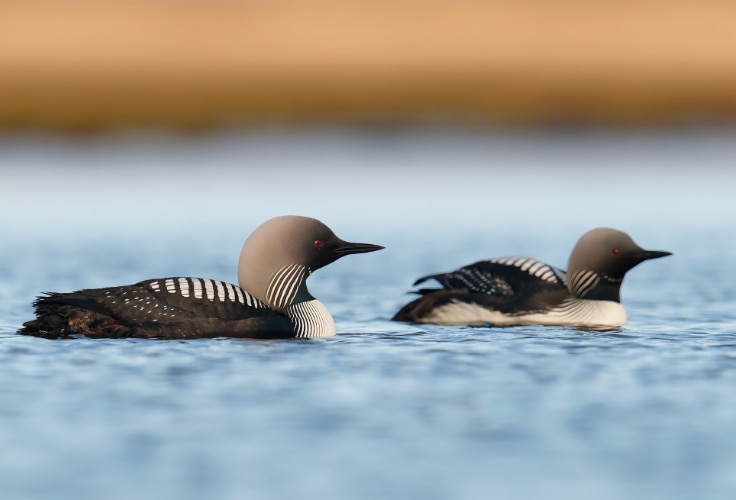
The Pacific loon is the most abundant of North America’s loon species, and the characteristic voice of the Arctic tundra. Slightly smaller and slimmer than the common loon, it measures 58 to 74 centimeters (22.8 to 29.1 inches) in length, with a sleek body, rounded head, and dagger-shaped bill usually held level while swimming. Its refined plumage and haunting calls make it one of the most elegant birds of northern waters.
In breeding plumage, adults show a soft silvery-gray crown and hindneck, a velvety black throat framed by vertical white lines, and a checkered black-and-white back and scapulars. The eyes glow red against the gray head. Non-breeding birds are brownish gray above and white below, often with a faint dark line across the throat and a subtle “chinstrap.” Juveniles resemble non-breeding adults but show more scalloped feather edges. Males and females look alike, though males average slightly larger.
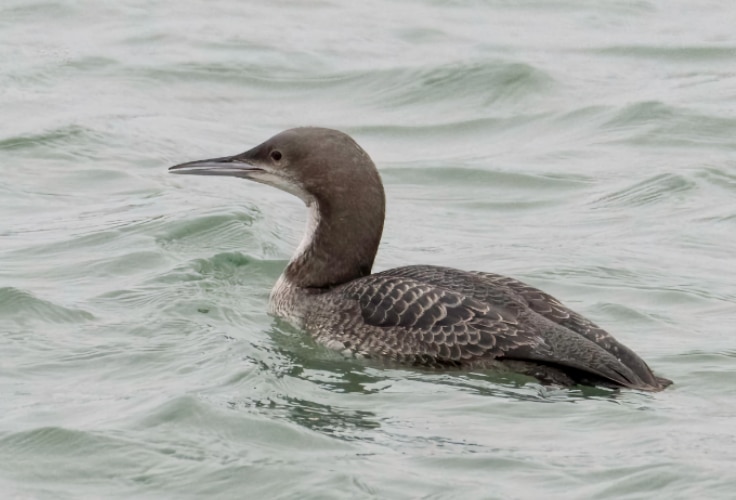
Pacific loons are strong divers and agile swimmers, thrusting themselves underwater with synchronized strokes of their large webbed feet. Before diving, they often raise the neck upright and spring slightly from the surface, unlike the smoother forward dive of the common loon. Their voices fill Arctic summer air with far-carrying wails, hoarse croaks, and rapid yodel-like series – calls that explorers once described as the most melancholy sounds of the tundra. They feed mainly on small fish and aquatic invertebrates, pursuing prey underwater by sight, or dipping and probing in shallow ponds.
This species breeds across the high Arctic and subarctic zones of Alaska and northern Canada, favoring deep, open tundra lakes with clear water and little emergent vegetation. Nests are built at the water’s edge, often on small islands or low shorelines within territories. After breeding, Pacific Loons migrate in large flocks along the coast, forming spectacular movements in spring when thousands pass northward over headlands. In winter, they gather widely along the Pacific Coast from Alaska to Baja California, mainly in bays, estuaries, and nearshore ocean waters, though some reach inland reservoirs or even the Atlantic coast.
Pacific loons remain numerous and broadly distributed, with no major evidence of decline, though long-term population trends are poorly known. Local threats include entanglement in fishing nets, disturbance from oil and gas development on breeding grounds, and ongoing subsistence harvest in Arctic communities. Despite these pressures, the species continues to thrive across much of its range, a resilient and haunting emblem of the northern coasts and tundra lakes.
Red-Throated Loon
Gavia stellata
- Identification: Smallest and most slender loon, with an upturned bill, gray head, and distinctive rust-red throat patch in breeding plumage; in winter, blackish above and white below with white face and neck.
- Where found: Breeds across Arctic and subarctic wetlands of Alaska and northern Canada; winters widely along both Atlantic and Pacific coasts, and locally on large inland lakes.
- How to spot: Look for its slim shape, slightly upturned bill, and graceful flight; listen for its plaintive wails and low growls over tundra lakes or note its buoyant flight along coasts.
- Conservation status: Least Concern (IUCN); populations stable after past declines, though threatened by oil spills, entanglement in nets, and habitat degradation in Arctic and marine zones.

The red-throated loon is the smallest and most delicate of North America’s loons, known for its elegance and mournful voice. Measuring 53 to 69 centimeters (20.9 to 27.2 inches) in length, it has a slender neck, narrow bill often held at a slight upward angle, and a light, graceful body. Its compact size allows it to take flight directly from land – unlike larger loons that must patter across the water’s surface.
In breeding plumage, adults display a smooth gray head and neck, finely striped nape, and a striking chestnut-red patch on the foreneck that gleams in good light. The upperparts are dark brownish-black with small white streaks and chevrons, and the underparts are white. In winter, the plumage turns plain: dark gray-brown above and clean white below, with a sharply defined white face and throat. Males and females appear alike, and immatures are duller, with mottled brown backs and muted neck colors.

Red-throated loons are agile divers and skillful flyers, capable of stalling, pivoting, or dropping onto prey with remarkable control. They hunt mainly small fish, capturing them underwater or, rarely, by plunging from the air. Unlike other loons, they often forage far from their nesting ponds, sometimes commuting long distances to the sea to feed. Their vocalizations range from soft coos and staccatos near the nest to eerie wails and growling “plesiosaur” calls that echo across Arctic tundra lakes, used in pair bonding and territorial displays.
Breeding occurs in Arctic and subarctic wetlands across Alaska and northern Canada, extending south along coastal British Columbia and Newfoundland. The species favors small, shallow ponds in low tundra and coastal plains, often nesting on the shore or small islands with easy water access. After breeding, it moves to coastal wintering grounds, where it becomes common along the Pacific Coast from Alaska to Baja California and along the Atlantic from Newfoundland to the Carolinas, concentrating in bays, estuaries, and upwelling zones rich in fish.
Globally widespread and still numerous, the red-throated loon suffered notable declines in the late twentieth century, particularly in parts of Europe and eastern North America, likely due to lake acidification and pollution. Populations now appear stable, though regional threats remain. Oil spills, gill-net bycatch, disturbance from coastal development, and Arctic industrial activity continue to affect local numbers. Despite these pressures, the red-throated loon remains a graceful and haunting presence from northern tundra ponds to winter seas.
Yellow-Billed Loon
Gavia adamsii
- Identification: Large loon with a thick neck, blocky head, and heavy yellow or ivory bill; in summer boldly checkered black-and-white with red eyes, in winter pale gray-brown above and white below.
- Where found: Breeds on tundra lakes across northern Alaska and Arctic Canada; winters mainly in nearshore Pacific waters from Alaska through the Aleutians to British Columbia, with rare inland or Atlantic records.
- How to spot: Look for the large, all-pale bill held slightly upward and its imposing size; haunting yodels carry across Arctic lakes, while slow, deliberate dives mark it on northern seas.
- Conservation status: Near Threatened (IUCN); populations small and declining due to habitat disturbance, oil development, and bycatch; most secure in Alaska’s protected Arctic reserves.

The yellow-billed loon is the largest and rarest of the world’s loons – a majestic bird of the High Arctic and a symbol of its remote northern lakes. Adults measure 77 to 92 centimeters (30.3 to 36.2 inches) in length and rival the common loon in mass but appear heavier-headed and thicker-necked. The distinctive pale bill, larger and deeper than that of any other loon, instantly identifies the species even at great distance.
In breeding plumage, adults show immaculate black upperparts patterned with bold white squares and streaks, white underparts, and a necklace of black-and-white lines across the lower neck. The head and neck shimmer black with a greenish gloss, and the bill gleams pale yellow or ivory against red eyes. In winter, the plumage softens to gray-brown above and white below, with a faintly barred back in young birds. Both sexes look alike, and immatures resemble duller versions of winter adults.
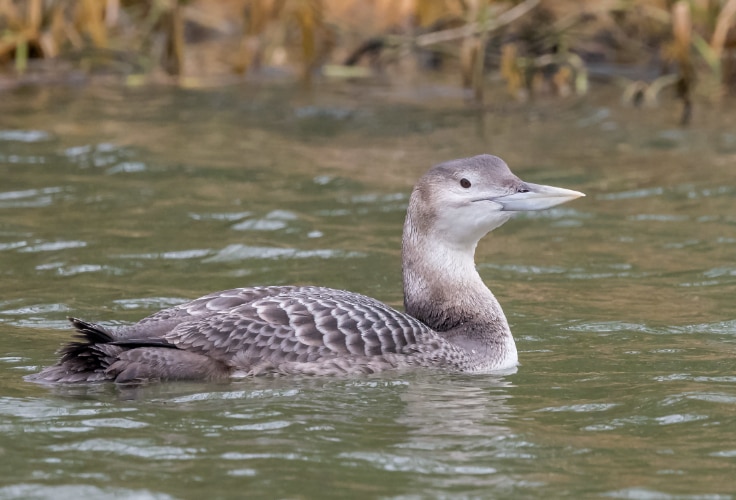
A powerful swimmer and diver, the yellow-billed loon spends nearly its entire life on water. It catches fish and aquatic invertebrates underwater by thrusting with its large webbed feet, often staying submerged for nearly a minute and resurfacing far from where it dove. Its calls resemble those of the common loon but are lower-pitched and slower – deep wails and long yodels that can carry for kilometers across Arctic tundra lakes. When alarmed, pairs give a tremolo-like laugh, and during territorial encounters males display by leaning forward with neck outstretched and issuing a long, swelling yodel.
The species breeds in low-lying, treeless tundra regions of northern Alaska and Arctic Canada, favoring large, clear lakes surrounded by sparse vegetation. Nests are built at the water’s edge, sometimes on narrow spits or small islands. After breeding, yellow-billed loons move to coastal waters, wintering mainly along the northern Pacific from Alaska through the Aleutian Islands to British Columbia, and occasionally farther south. Some individuals wander inland, appearing on large reservoirs across the interior West and rarely on the Great Lakes.
Although still locally common in parts of Alaska, the yellow-billed loon has declined significantly over recent decades and is considered a threatened species globally. Its small population is vulnerable to habitat disturbance, oil and gas development in Arctic breeding areas, and entanglement in fishing nets. Most of Alaska’s breeding population occurs within the National Petroleum Reserve, where conservation measures now limit industrial impacts. Protecting these pristine tundra lakes and their fragile ecosystems remains essential to ensure the survival of this impressive Arctic diver.
Arctic Loon
Gavia arctica
- Identification: Medium-sized loon with gray head, white-checkered back, and bold black-and-white stripes on the neck; in all plumages shows a distinctive white flank patch visible on the water.
- Where found: Widespread across northern Eurasia; in North America breeds locally in western Alaska and winters mainly along sheltered coasts of the North Pacific, rarely south to California or Baja.
- How to spot: Look for the pale gray head, crisp neck stripes, and bright white flank patch; slightly larger and paler than Pacific loon with a more level bill and darker nape.
- Conservation status: Least Concern (IUCN); populations large across Eurasia but small and local in Alaska, potentially sensitive to disturbance and coastal habitat change.

The Arctic loon is a strikingly patterned diver of the northern lakes, known for its soft gray head, bold neck striping, and gleaming white flanks. It is closely related to and often confused with the Pacific loon, but is slightly larger with a darker nape, more extensive white on the sides, and a bill usually held level rather than uptilted. Adults measure 58 to 73 centimeters (23 to 29 inches) in length and display a trim, streamlined profile suited to long-distance migration and deep diving.
In breeding plumage, this loon shows a smooth gray head and hindneck, a greenish or purplish gloss across the lower throat, and a striking vertical pattern of white lines down the neck. The black back is covered with large white squares, and the chest bears fine parallel striping. In non-breeding plumage, it turns gray-brown above and white below, with a neat, sharp border between the darker crown and pale face. Juveniles are similar to winter adults but browner overall, with faint buffy scaling on the back. Both sexes are alike in appearance.
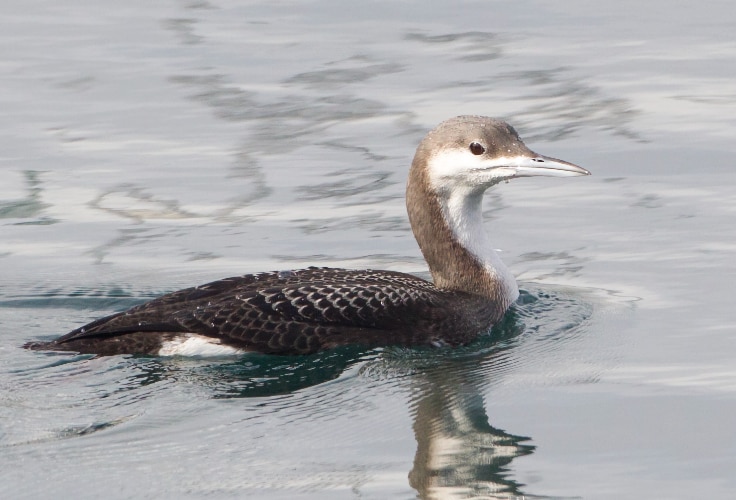
Arctic loons are graceful swimmers and strong divers, propelling themselves underwater with their powerful feet. Before diving, they often raise the neck upright and spring slightly from the surface, as seen in Pacific loons. Their calls are melodic, carrying yodels and wails that echo across boreal lakes in the breeding season. On the nesting grounds, pairs are territorial and long-bonded, constructing shoreline nests together and rearing chicks that ride on the parents’ backs before learning to dive and fish independently.
The species breeds widely across northern Eurasia, from Scandinavia and the British Isles east across Siberia to the Pacific coast, and in North America only locally around the Seward Peninsula and Kotzebue Sound in western Alaska. Breeding lakes are typically large, deep, and clear, often with small islands or sheltered bays. In winter, Arctic loons occupy inshore marine waters, coastal bays, and sheltered seas, ranging from northern Europe to Japan and occasionally along the North American Pacific coast to California and Baja California.
Globally, the Arctic loon remains common across its broad Eurasian range. The small Alaskan population is much more limited and therefore vulnerable to environmental changes and human disturbance. Oil development, climate-driven habitat shifts, and contamination of Arctic freshwater systems could pose future risks. Nonetheless, this elegant loon remains a widespread and enduring emblem of northern lakes and coastal seas, bridging the Arctic realms of both continents.
Loons and the Northern Wilderness
From the Arctic tundra to the northern forests and coasts, loons embody the wilderness of North America’s lakes and seas. Though they differ in size, range, and abundance, all share the same aquatic mastery – powerful divers, graceful swimmers, and voices that carry for miles across open water. Protecting the clear lakes and unspoiled coastal habitats these birds depend on remains essential, ensuring that their presence and calls continue to define the wild character of northern waters.



